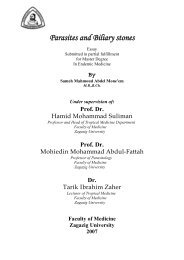E. Coli
E. Coli
E. Coli
You also want an ePaper? Increase the reach of your titles
YUMPU automatically turns print PDFs into web optimized ePapers that Google loves.
Review of Literature<br />
salmonella species were isolated. Five salmonella serotypes were<br />
identified; S. typhomurium was the most common one of them.<br />
Irwin et al. (1989) studied the prevalent of Salmonella species in<br />
Ontario broiler chicken by culturing cloacal samples from 500<br />
individual birds selected from 50 poultry farms. Results of cloacal<br />
samples revealed, the presence of 19/500 (3.8%) samples contained<br />
salmonella species. Nine different salmonella species serotypes were<br />
isolated, the most common being S.hadar, S.heidelberg and S.<br />
mbandaka.<br />
Machado and Bernardo (1990) carried out a bacteriological<br />
examination of 300 chicken carcasses during the period of 1986-1987.<br />
it was found that 57% of the examined carcasses were contaminated<br />
with salmonella species. By serotyping, 3% of the salmonella strains<br />
were S.typhimurium.<br />
Poppe et al. (1991) estimated that the prevalence of salmonella<br />
species among Canadian commercial broiler flocks. They found that<br />
environmental (Litter and/or water) samples from 226 of 294 (76.9%)<br />
were contaminated with salmonella litter samples were more often<br />
contaminated with salmonella than water samples (47.4 versus<br />
12.3%). The most prevalent salmonella serovars from 50 salmonella<br />
strains were S.hadar, S.infantis and S.schwarzengrund; they were<br />
isolated from samples of 98/294 (33.3%), 26/294 (8.8%) and 21/294<br />
(7.1%) respectively. Thirty nine from 290 (13.4%) feed samples were<br />
contaminated with Salmonella enteritidis was isolated from<br />
environmental samples of 9/294 (3.1%).<br />
11
















